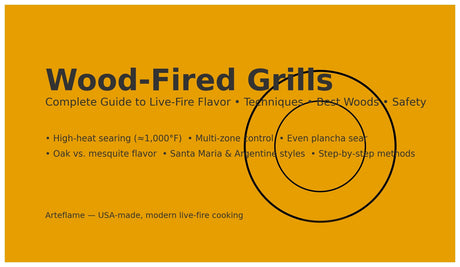
Wood-Fired Grills: Buyer’s Guide, Woods, Tips & FAQs
Learn the best wood-fired grill types, woods, techniques, and safety temps—plus how to get a steakhouse sear at home with multi-zone live fire.
Surströmming, Sweden’s famously fermented Baltic herring, is one of the boldest flavors you can put on your plate. While usually served cold with flatbread, potatoes, and onions, grilling it on the Arteflame brings this delicacy to a whole new level. The grill’s unique design—with a roaring 1,000°F center sear zone and progressively cooler zones toward the edge—lets you control the heat perfectly. This means you can give the fish and sides just the right amount of smokiness, crisp texture, and balance without overwhelming their flavor.
1 can surströmming (fermented Baltic herring)
4 medium potatoes, boiled and halved
1 red onion, thinly sliced
4 soft flatbreads (tunnbröd or any soft flatbread)
2 tbsp butter (for grilling)
Chives, chopped (for garnish)
Sour cream (optional)
Light your Arteflame by placing oil-soaked napkins in the base, stacking firewood over them, and igniting. In about 20 minutes, the cooktop will be ready. The center grate will exceed 1,000°F for steakhouse-level searing, while the outer cooktop zones give you a perfect gradient of lower heat for warming and toasting.
Open the can outdoors—the aroma is famously intense. Drain the herring and gently rinse under cold water. Handle with care, as the fish is very delicate.
Potatoes: Place the boiled potato halves cut-side down closer to the center heat zone, where the temperature is high but not scorching. Let them form a deep golden-brown crust before sliding them outward to stay warm.
Surströmming: Melt butter on the outer, cooler section of the cooktop. Lay the fish there and grill gently, about 2–3 minutes per side, until the outside crisps lightly without drying out. The lower heat zone keeps the flavor intact while adding just enough smoke.
Briefly warm each flatbread on the outer rim of the cooktop. They should be soft and pliable with just a touch of toast.
Spread sour cream (optional) on the flatbread. Add grilled surströmming, golden potatoes, and raw onion slices. Sprinkle with chives. Roll or fold into wraps and serve immediately with more sour cream on the side.
Use the heat zones wisely: Potatoes can handle the higher heat closer to the center, while surströmming should always stay on the cooler outer ring.
Sear, then slide: The Arteflame’s 1,000°F zone is perfect for quick caramelization (like on potatoes), then move food outward to control doneness.
Balance the flavors: The butter mellows the fish, while onions and chives add sharpness for contrast.
Cream Cheese Swap: Replace sour cream with cream cheese for extra richness.
Herbed Freshness: Add dill or parsley for bright Scandinavian flavors.
Spicy Kick: Top with chili slices or drizzle hot sauce.
Garden Crunch: Add cucumber and radish for refreshing texture.
Cheesy Melt: Sprinkle grated cheese over the flatbread while warming it on the cooktop.
Boiled Potatoes: A classic partner that soaks up flavor.
Sour Cream: Smooth and cooling, it balances the herring’s tang.
Crispbread (Knäckebröd): For extra crunch instead of flatbread.
Grilling surströmming on the Arteflame is about transforming one of the world’s most polarizing delicacies into a smoky, crisp, and surprisingly balanced dish. By harnessing the grill’s blazing 1,000°F sear zone for potatoes and its cooler edges for delicate fish, you get the best of both worlds—texture, flavor, and authenticity with a smoky Arteflame twist.
Arteflame XXL 40" Flat Top Grill - High Euro Base
Arteflame ONE30 — 30″ One Series Flat-Top Charcoal Grill & Fire Bowl (Single-Piece CORTEN Steel)